- Joined
- Feb 2, 2011
- Messages
- 2,248
THE ANGLO ZULU WAR
THE BATTLE OF GINGINDHLOVU, 2nd APRIL 1879
The Battle of Gingindhlovu was fought on 2nd April 1879 between a British relief column sent to break the siege at Eshowe, and a Zulu impi of king Cetshwayo.
The British soldier would refer to it as the Battle of “GIN GIN I LOVE YOU”.
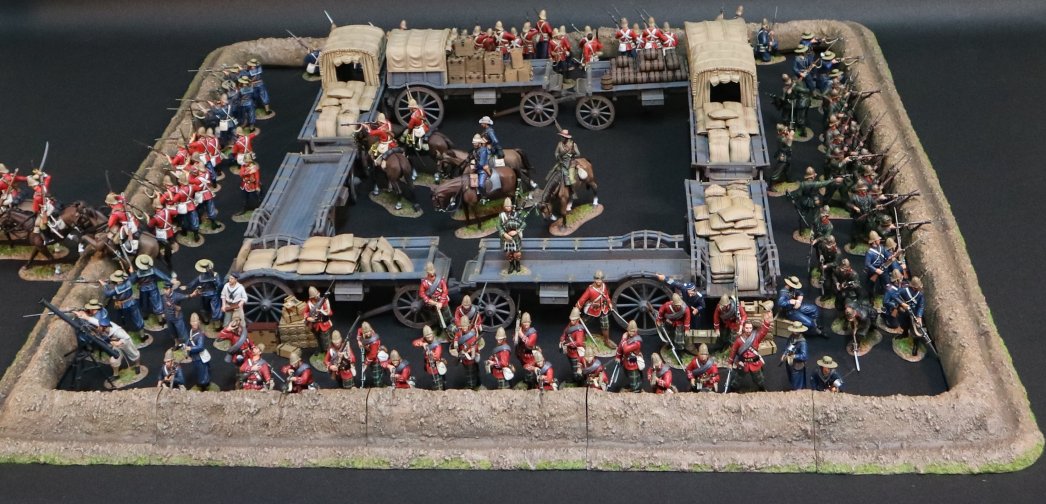
Charles Pearson had led No.1 column of the British invasion force across the Tugela River to establish an advanced base at Eshowe. Having set up a base at a deserted Norwegian mission station, the British found themselves besieged.
A relief column was organized by Lord Chelmsford and departed Fort Tenedos on 29th March to relieve the garrison.
Chelmsford’s relief force comprised 3,390 Europeans, and 2,280 Africans.
Lord Chelmsford ensured his men spent much time laagering and entrenching their camp at the end of each day, and kept ammunition boxes open and at the ready.
Although this was slow progress, Pearson’s observers at Eshowe were able to see the relief column entrenched on the south bank of the Neyzane, on the evening of the 1st April.
BRITISH LAAGER/ENTRENCHED DEFENCES
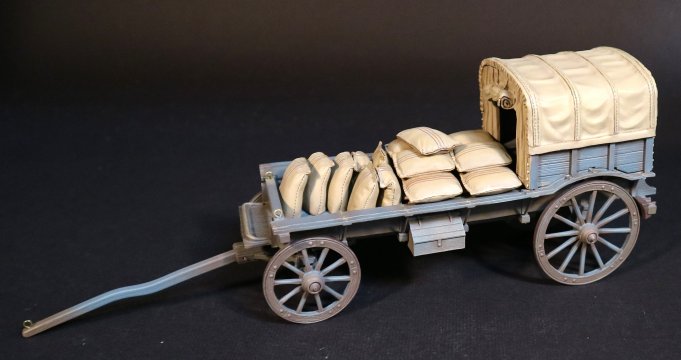
GG-107
THE ANGLO ZULU WAR
THE BATTLE OF GINGINDHLOVU, 2nd APRIL 1879,
THE ESHOWE RELIEF COLUMN,
BRITISH LAAGER/ENTRENCHED DEFENCES,
OX WAGON
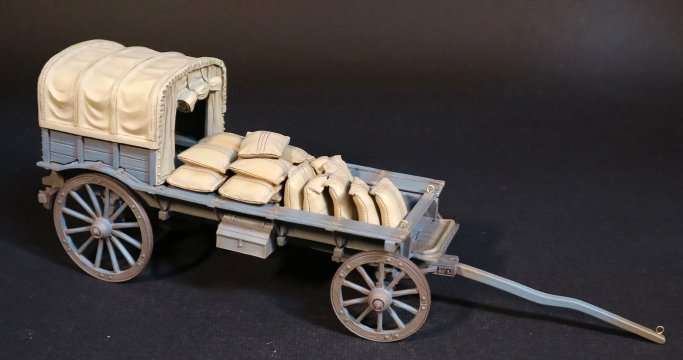
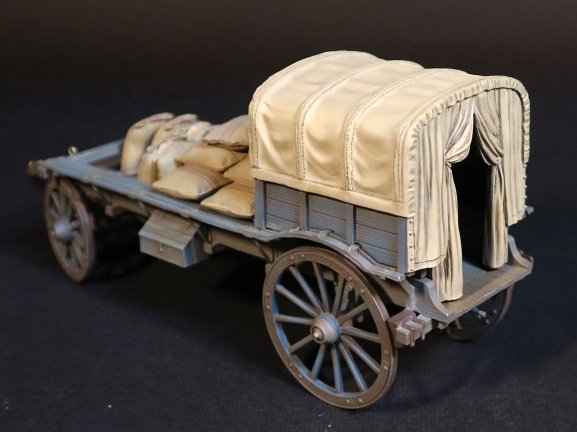

PLEASE NOTE THERE ARE ALTOGETHER 5 DIFFERENT WAGONS. THE NEXT FOUR WILL BE RELEASED OVER THE NEXT FOUR MONTHS.
The Zulu impi was composed of 12,000 warriors, some of whom were Isandlwana veterans drawn from regiments in the main Zulu army, while the remainder were warriors who lived in the vicinity of Eshowe.
Many of the Zulu commanders wanted to attack the relief column that night, but Prince Dabulamanzi KaMpande, who was half brother to king Cetshwayo and commander of the impi’s right wing, convinced them to wait until morning.
At dawn on 2 April 1879, the morning sun revealed muddy ground and a heavy mist. Chelmsford had decided after hearing Dunn's report to not continue on toward Eshowe early the next morning. Instead, he would deploy units of the Natal Native Contingent to feel for the Zulus. As the NNC were preparing to advance shots were heard from the night pickets still on duty. The impi was advancing; the main force split into two columns before crossing the Ineyzane and assuming the "chest and horns" formation. The left horn sharply curved to the right to assault the laager's north-east corner, while the "chest" gently curved toward the north face of the laager.
Another force passed Misi Hill and approached the laager, forming the impi’s right horn.
The buffalo formation came in at a run on the three sides of the laager as Chelmsford had wanted; at a range of 300–400 yd (270–370 m) the British infantry opened fire, supported by the Gatling guns and rockets.
Zulu marksmen caused a few casualties within the laager, but the defenders kept the Zulus at bay.
Although the Zulu regiments made persistent rushes to get within stabbing range, their charges lacked the drive and spirit that had pushed them forward at Isandlwana and Rorke’s Drift.
The only zulu to reach the laager was a ten year old boy, who was immediately taken prisoner by members of the naval brigade and later served as a kind of mascot on their ship, Boadicea.
Around 7am, the main impi attack had been halted. Chelmsford ordered his mounted troops to attack, followed by the NNC.
Many zulu were killed as they withdrew.
Chelmsford had begun to avenge the Imperial dead of Isandlwana, but for the present he was content to relieve Pearson and return to Natal.
THE 57th (WEST MIDDLESEX) REGIMENT
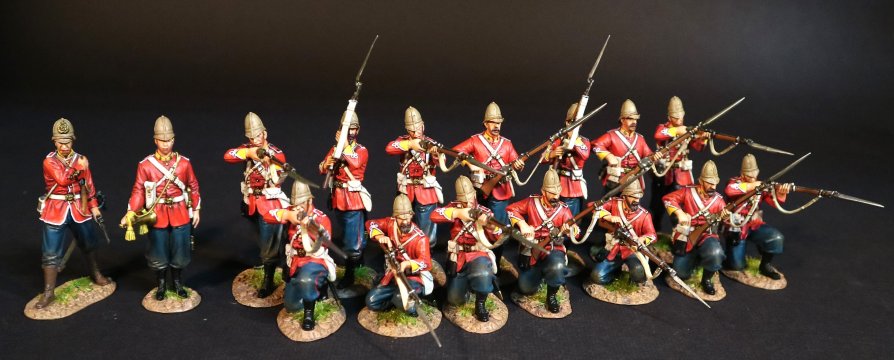
The regiment was stationed in Ceylon when in February 1879, it received orders to proceed to Natal. On its journey it joined the 1st Brigade of the column that was being formed for the relief of Eshowe.
They held the right flank face of the laager at Gingindhlovu and assisted in repelling the first enemy attack.
During the second invasion of Zululand they were in the 2nd Brigade of Crealock’s 1st Division.
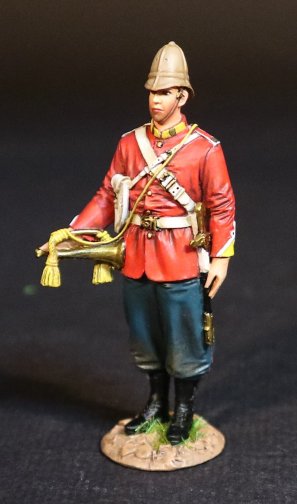
GG57-05
THE ANGLO ZULU WAR
THE BATTLE OF GINGINDHLOVU, 2nd APRIL 1879,
THE ESHOWE RELIEF COLUMN,
THE 57th (WEST MIDDLESEX) REGIMENT
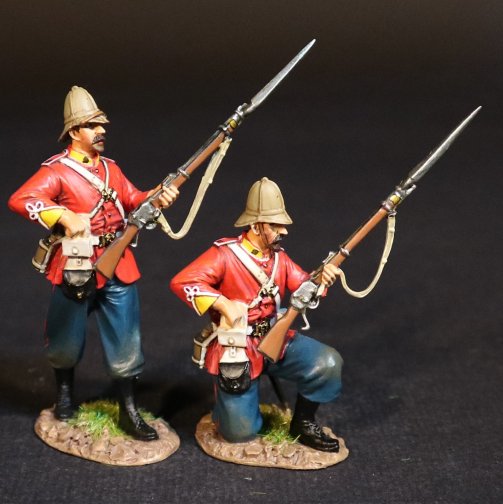
GG57-02
THE ANGLO ZULU WAR
THE BATTLE OF GINGINDHLOVU, 2nd APRIL 1879,
THE ESHOWE RELIEF COLUMN,
THE 57th (WEST MIDDLESEX) REGIMENT
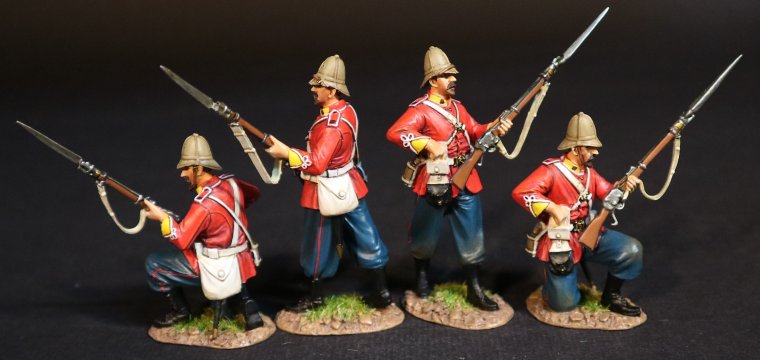
GG57-02N
THE ANGLO ZULU WAR
THE BATTLE OF GINGINDHLOVU, 2nd APRIL 1879,
THE ESHOWE RELIEF COLUMN,
THE 57th (WEST MIDDLESEX) REGIMENT
MOUNTED INFANTRY
At the beginning of the campaign Chelmsford had no regular cavalry regiments at his disposal, which was a setback given the cavalry traditional role of scouting and pursuit.
He did however have two understrength squadrons of Mounted Infantry, who were distributed throughout the invading columns.

The Mounted Infantry consisted of selected soldiers from infantry regiments mounted on locally acquired horses.
During the Zulu war the men of the mounted infantry, chosen from nearly every infantry battalion, wore their regiment’s tunic, cord breeches and riding boots.
They were armed with Martini-Henry rifles, and instead of the usual infantry equipment carried a bandolier.
Despite the mixed origins of this Mounted Infantry force, it performed extremely well, and paved the way for greater reliance on Mounted Infantry units in later campaigns.
Major P. H. S. Barrow was to command the 70 Mounted Infantry at Gingindhlovu, and had armed the men with sabres.
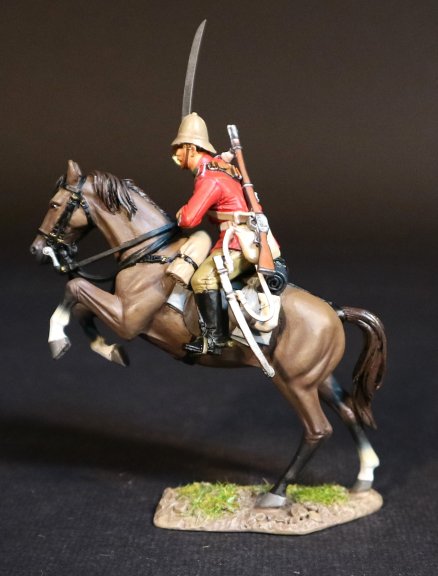
GGMI-08
THE ANGLO ZULU WAR
THE BATTLE OF GINGINDHLOVU, 2nd APRIL 1879,
THE ESHOWE RELIEF COLUMN,
MOUNTED INFANTRY
THE ZULU IMPI
The Zulu impi was composed of 12,000 warriors, some of whom were Isandlwana veterans drawn from regiments in the main Zulu army, while the remainder were warriors who lived in the vicinity of Eshowe.
Many of the Zulu commanders wanted to attack the relief column that night, but Prince Dabulamanzi KaMpande, who was half brother to king Cetshwayo and commander of the impi’s right wing, convinced them to wait until morning.
At dawn on 2 April 1879, the morning sun revealed muddy ground and a heavy mist. Chelmsford had decided after hearing Dunn's report to not continue on toward Eshowe early the next morning. Instead, he would deploy units of the Natal Native Contingent to feel for the Zulus. As the NNC were preparing to advance shots were heard from the night pickets still on duty. The impi was advancing; the main force split into two columns before crossing the Ineyzane and assuming the "chest and horns" formation. The left horn sharply curved to the right to assault the laager's north-east corner, while the "chest" gently curved toward the north face of the laager.
The robust and vigorous Zulu clansman was the result of his upbringing, his entire boyhood being spent on the veldt tending cattle. This outdoor existence not only toughened his body and gave him great endurance but also gave him extensive knowledge of the terrain of his homeland.
By 1879 the Zulu army consisted of 33 regiments.
These regiments were more than just military units, they were an integral part of the Zulu social system and once formed could only be broken by death, for there was no retirement or buying out in the Zulu army and men in their 60’s and 70’s as long as they were physically able to take the field, answered the King’s call to arms.
uTHULWANA REGIMENT
Zulu regiments were known as “amabutho”, and the uThulwana regiment was formed in 1854, and was named after a Basuto chief.
It was also known as ”Dust Raisers” or “Cover with Dust”
Formed around the 18th Century AD (as one of King Shaka's ''original Lions''), they occupied the all-important position of ''Chest'' in The Zulu Attack Formation called ''The Beasts Horns''.
The Regiment was one of the largest – numbering around 3,000.
The uThulwana Regiment was a ''Front Line'' Zulu Military Formation of The Zulu Empire.
The basic Zulu military formation, made up of several “amabutho” was known as an “Impi”
It was a white shield regiment in which Cetshwayo once served.

The regiment had a stormy and divided history. It had been involved with a feud against the inGobamakhosi regiement over women.
In 1878 Cetshwayo gave the uThulwana permission to marry the female intanga that had been assigned to them, the inGcugce.
The uThulwana had been kept waiting for a long time for permission to marry, and men were now in their forties, but the girls of the inGcugce had been enrolled at about the same time as the inGobamakhosi, and most of them in their late teens had already formed pre marriage partnerships with the men of the younger regiment.
When the uThulwana adorned with new headrings appeared to claim their brides, most of the girls had run off into the bush and could not be found.
There was a fight in which the uThulwana set about every man not wearing a headring, and the inGobamakhosi attacked every man with one.
The conflict was never resolved and whenever the two regiments came into contact the quarrel would flare up again.
At Isandlwana both regiments were drawn up well apart from one another.
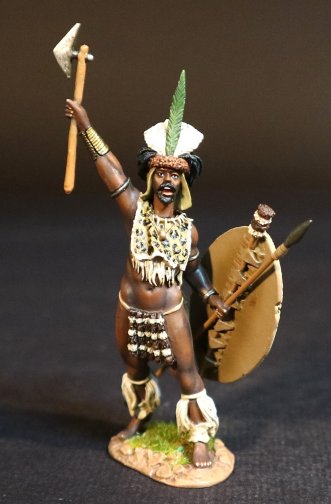
GGZ-01
THE ANGLO ZULU WAR
THE BATTLE OF GINGINDHLOVU, 2nd APRIL 1879,
THE ZULU IMPI.
THE uTHULWANA REGIMENT,
INDUNA
Part of the regiment rebelled and joined Cetshwayo’s half brother, and some actually joined the NNC in an early action against one of the indunas of the inGobamakhosi.
Most of the regiment was to serve the king loyally, and fought bravely at Isandlwana, and at the attack on Rorke’s Drift. As well as at Gingindhlovu and finally at Ulundi under Dabulamanzi.
The regiment wore a headdress which included a brown crane feather, otter skin head band, monkey skin amabheqe, sakabula feathers and white ostrich feathers.
This ceremonial dress was apparently worn into battle.
Contact your Dealer for pre-order information!
THE BATTLE OF GINGINDHLOVU, 2nd APRIL 1879
The Battle of Gingindhlovu was fought on 2nd April 1879 between a British relief column sent to break the siege at Eshowe, and a Zulu impi of king Cetshwayo.
The British soldier would refer to it as the Battle of “GIN GIN I LOVE YOU”.

Charles Pearson had led No.1 column of the British invasion force across the Tugela River to establish an advanced base at Eshowe. Having set up a base at a deserted Norwegian mission station, the British found themselves besieged.
A relief column was organized by Lord Chelmsford and departed Fort Tenedos on 29th March to relieve the garrison.
Chelmsford’s relief force comprised 3,390 Europeans, and 2,280 Africans.
Lord Chelmsford ensured his men spent much time laagering and entrenching their camp at the end of each day, and kept ammunition boxes open and at the ready.
Although this was slow progress, Pearson’s observers at Eshowe were able to see the relief column entrenched on the south bank of the Neyzane, on the evening of the 1st April.
BRITISH LAAGER/ENTRENCHED DEFENCES

GG-107
THE ANGLO ZULU WAR
THE BATTLE OF GINGINDHLOVU, 2nd APRIL 1879,
THE ESHOWE RELIEF COLUMN,
BRITISH LAAGER/ENTRENCHED DEFENCES,
OX WAGON



PLEASE NOTE THERE ARE ALTOGETHER 5 DIFFERENT WAGONS. THE NEXT FOUR WILL BE RELEASED OVER THE NEXT FOUR MONTHS.
The Zulu impi was composed of 12,000 warriors, some of whom were Isandlwana veterans drawn from regiments in the main Zulu army, while the remainder were warriors who lived in the vicinity of Eshowe.
Many of the Zulu commanders wanted to attack the relief column that night, but Prince Dabulamanzi KaMpande, who was half brother to king Cetshwayo and commander of the impi’s right wing, convinced them to wait until morning.
At dawn on 2 April 1879, the morning sun revealed muddy ground and a heavy mist. Chelmsford had decided after hearing Dunn's report to not continue on toward Eshowe early the next morning. Instead, he would deploy units of the Natal Native Contingent to feel for the Zulus. As the NNC were preparing to advance shots were heard from the night pickets still on duty. The impi was advancing; the main force split into two columns before crossing the Ineyzane and assuming the "chest and horns" formation. The left horn sharply curved to the right to assault the laager's north-east corner, while the "chest" gently curved toward the north face of the laager.
Another force passed Misi Hill and approached the laager, forming the impi’s right horn.
The buffalo formation came in at a run on the three sides of the laager as Chelmsford had wanted; at a range of 300–400 yd (270–370 m) the British infantry opened fire, supported by the Gatling guns and rockets.
Zulu marksmen caused a few casualties within the laager, but the defenders kept the Zulus at bay.
Although the Zulu regiments made persistent rushes to get within stabbing range, their charges lacked the drive and spirit that had pushed them forward at Isandlwana and Rorke’s Drift.
The only zulu to reach the laager was a ten year old boy, who was immediately taken prisoner by members of the naval brigade and later served as a kind of mascot on their ship, Boadicea.
Around 7am, the main impi attack had been halted. Chelmsford ordered his mounted troops to attack, followed by the NNC.
Many zulu were killed as they withdrew.
Chelmsford had begun to avenge the Imperial dead of Isandlwana, but for the present he was content to relieve Pearson and return to Natal.
THE 57th (WEST MIDDLESEX) REGIMENT

The regiment was stationed in Ceylon when in February 1879, it received orders to proceed to Natal. On its journey it joined the 1st Brigade of the column that was being formed for the relief of Eshowe.
They held the right flank face of the laager at Gingindhlovu and assisted in repelling the first enemy attack.
During the second invasion of Zululand they were in the 2nd Brigade of Crealock’s 1st Division.

GG57-05
THE ANGLO ZULU WAR
THE BATTLE OF GINGINDHLOVU, 2nd APRIL 1879,
THE ESHOWE RELIEF COLUMN,
THE 57th (WEST MIDDLESEX) REGIMENT

GG57-02
THE ANGLO ZULU WAR
THE BATTLE OF GINGINDHLOVU, 2nd APRIL 1879,
THE ESHOWE RELIEF COLUMN,
THE 57th (WEST MIDDLESEX) REGIMENT

GG57-02N
THE ANGLO ZULU WAR
THE BATTLE OF GINGINDHLOVU, 2nd APRIL 1879,
THE ESHOWE RELIEF COLUMN,
THE 57th (WEST MIDDLESEX) REGIMENT
MOUNTED INFANTRY
At the beginning of the campaign Chelmsford had no regular cavalry regiments at his disposal, which was a setback given the cavalry traditional role of scouting and pursuit.
He did however have two understrength squadrons of Mounted Infantry, who were distributed throughout the invading columns.

The Mounted Infantry consisted of selected soldiers from infantry regiments mounted on locally acquired horses.
During the Zulu war the men of the mounted infantry, chosen from nearly every infantry battalion, wore their regiment’s tunic, cord breeches and riding boots.
They were armed with Martini-Henry rifles, and instead of the usual infantry equipment carried a bandolier.
Despite the mixed origins of this Mounted Infantry force, it performed extremely well, and paved the way for greater reliance on Mounted Infantry units in later campaigns.
Major P. H. S. Barrow was to command the 70 Mounted Infantry at Gingindhlovu, and had armed the men with sabres.

GGMI-08
THE ANGLO ZULU WAR
THE BATTLE OF GINGINDHLOVU, 2nd APRIL 1879,
THE ESHOWE RELIEF COLUMN,
MOUNTED INFANTRY
THE ZULU IMPI
The Zulu impi was composed of 12,000 warriors, some of whom were Isandlwana veterans drawn from regiments in the main Zulu army, while the remainder were warriors who lived in the vicinity of Eshowe.
Many of the Zulu commanders wanted to attack the relief column that night, but Prince Dabulamanzi KaMpande, who was half brother to king Cetshwayo and commander of the impi’s right wing, convinced them to wait until morning.
At dawn on 2 April 1879, the morning sun revealed muddy ground and a heavy mist. Chelmsford had decided after hearing Dunn's report to not continue on toward Eshowe early the next morning. Instead, he would deploy units of the Natal Native Contingent to feel for the Zulus. As the NNC were preparing to advance shots were heard from the night pickets still on duty. The impi was advancing; the main force split into two columns before crossing the Ineyzane and assuming the "chest and horns" formation. The left horn sharply curved to the right to assault the laager's north-east corner, while the "chest" gently curved toward the north face of the laager.
The robust and vigorous Zulu clansman was the result of his upbringing, his entire boyhood being spent on the veldt tending cattle. This outdoor existence not only toughened his body and gave him great endurance but also gave him extensive knowledge of the terrain of his homeland.
By 1879 the Zulu army consisted of 33 regiments.
These regiments were more than just military units, they were an integral part of the Zulu social system and once formed could only be broken by death, for there was no retirement or buying out in the Zulu army and men in their 60’s and 70’s as long as they were physically able to take the field, answered the King’s call to arms.
uTHULWANA REGIMENT
Zulu regiments were known as “amabutho”, and the uThulwana regiment was formed in 1854, and was named after a Basuto chief.
It was also known as ”Dust Raisers” or “Cover with Dust”
Formed around the 18th Century AD (as one of King Shaka's ''original Lions''), they occupied the all-important position of ''Chest'' in The Zulu Attack Formation called ''The Beasts Horns''.
The Regiment was one of the largest – numbering around 3,000.
The uThulwana Regiment was a ''Front Line'' Zulu Military Formation of The Zulu Empire.
The basic Zulu military formation, made up of several “amabutho” was known as an “Impi”
It was a white shield regiment in which Cetshwayo once served.

The regiment had a stormy and divided history. It had been involved with a feud against the inGobamakhosi regiement over women.
In 1878 Cetshwayo gave the uThulwana permission to marry the female intanga that had been assigned to them, the inGcugce.
The uThulwana had been kept waiting for a long time for permission to marry, and men were now in their forties, but the girls of the inGcugce had been enrolled at about the same time as the inGobamakhosi, and most of them in their late teens had already formed pre marriage partnerships with the men of the younger regiment.
When the uThulwana adorned with new headrings appeared to claim their brides, most of the girls had run off into the bush and could not be found.
There was a fight in which the uThulwana set about every man not wearing a headring, and the inGobamakhosi attacked every man with one.
The conflict was never resolved and whenever the two regiments came into contact the quarrel would flare up again.
At Isandlwana both regiments were drawn up well apart from one another.

GGZ-01
THE ANGLO ZULU WAR
THE BATTLE OF GINGINDHLOVU, 2nd APRIL 1879,
THE ZULU IMPI.
THE uTHULWANA REGIMENT,
INDUNA
Part of the regiment rebelled and joined Cetshwayo’s half brother, and some actually joined the NNC in an early action against one of the indunas of the inGobamakhosi.
Most of the regiment was to serve the king loyally, and fought bravely at Isandlwana, and at the attack on Rorke’s Drift. As well as at Gingindhlovu and finally at Ulundi under Dabulamanzi.
The regiment wore a headdress which included a brown crane feather, otter skin head band, monkey skin amabheqe, sakabula feathers and white ostrich feathers.
This ceremonial dress was apparently worn into battle.
Contact your Dealer for pre-order information!

